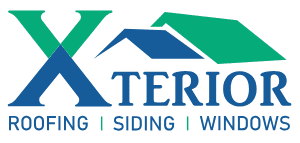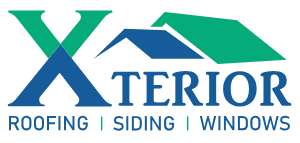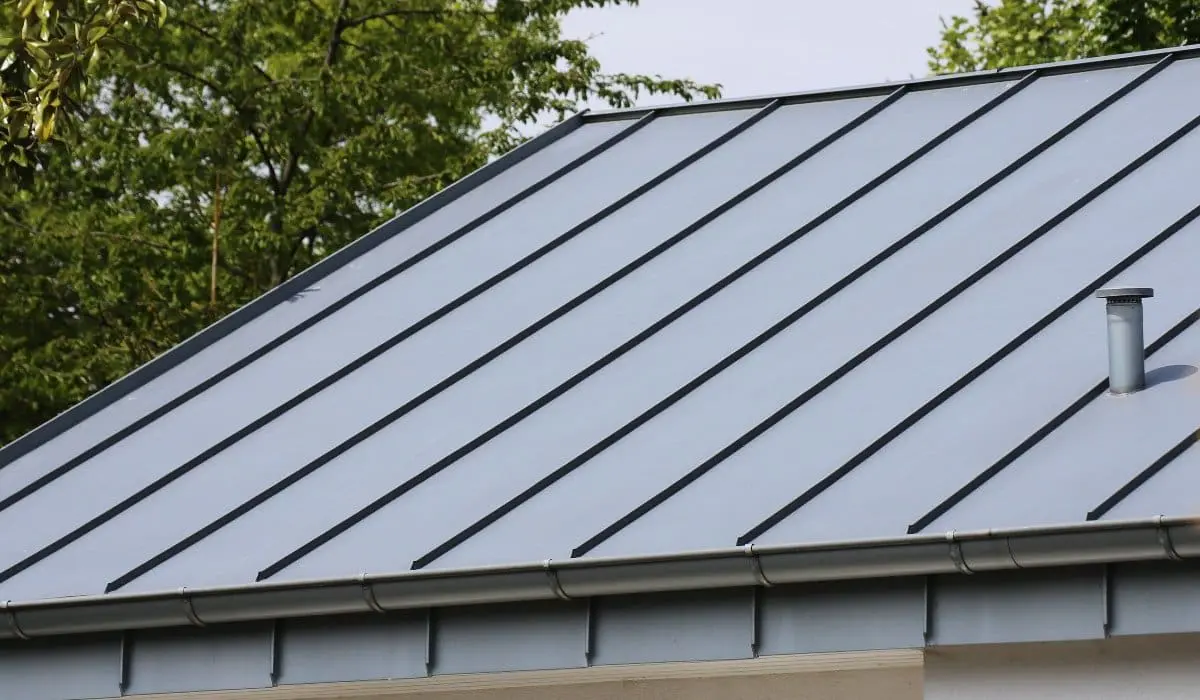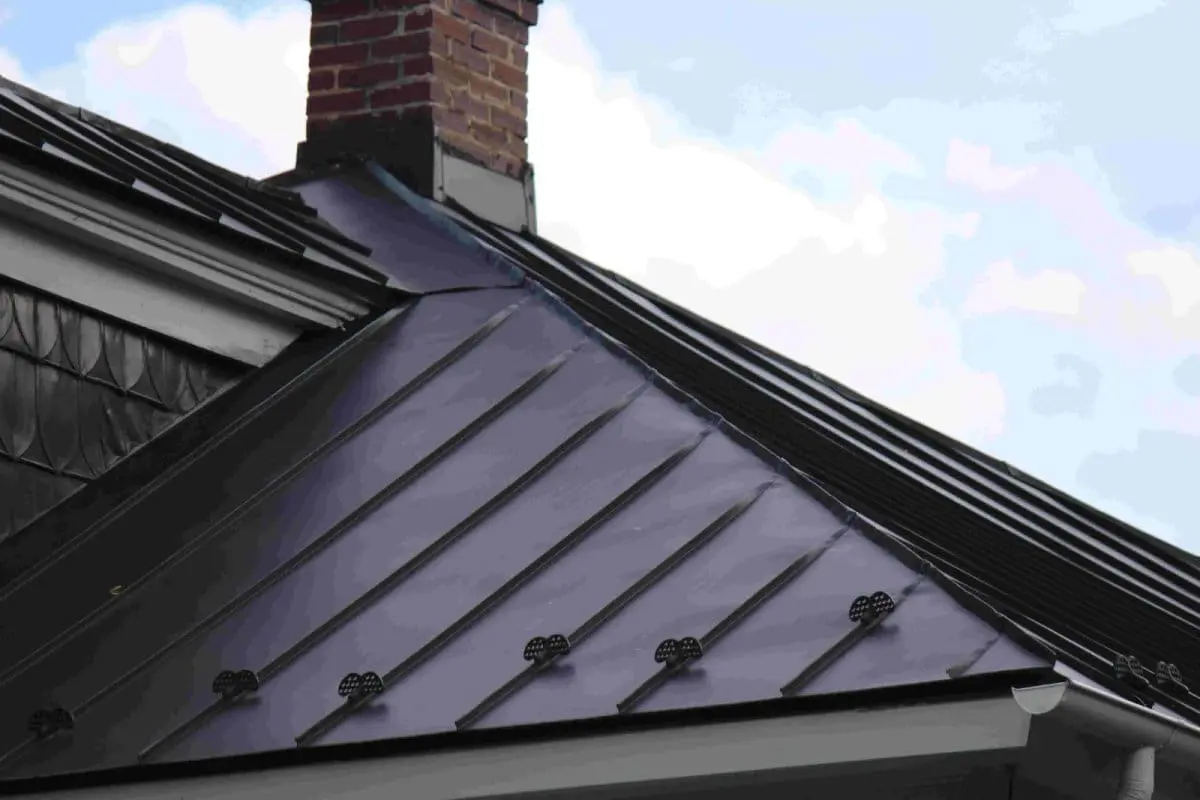Are you installing a metal roof? Knowing the minimum slope for a metal roof is crucial for weatherproofing and longevity. While traditional metal roofs typically require a minimum slope of 3:12, options like standing seam systems might go as low as 1/4:12.
Dive deeper into this article to ensure your metal roof meets these essential criteria, including the minimum slope for metal roof requirements.
Key Takeaways
- The slope or pitch of a metal roof is crucial for water drainage, weather resistance, and longevity. Steadier slopes generally require less maintenance due to their superior water-shedding capabilities.
- Minimum slope requirements for metal roofing vary by type. Standing seam metal roofs can have a slope as low as 1/4:12, while corrugated metal panels typically require a minimum of 1/2:12. However, this can differ based on specific products, like the R Panel, which needs a minimum of 1:12.
- Professional installation of a metal roof is essential. Strict adherence to manufacturer’s guidelines and attention to detail in every aspect of the installation process are critical to avoid leaks and ensure weather-tight, long-lasting performance.
Crucial Role of Slope in Metal Roofing
When it comes to metal roofing, the importance of the roof slope cannot be overstated. The pitch, a critical component of architectural design, determines the functionality and longevity of homes. A well-calculated slope on your metal roof accentuates the design and underpins the roofing system’s performance.
Whether dealing with intense rainstorms or heavy snow, the proper roof slopes ensure your metal roof stands strong against the elements.
Impact of Slope on Water Drainage
A metal roof must be inclined adequately to channel rainwater away from the foundation, preventing long-term damage. The consequences of inadequate slope are significant, with ponding water, leaks, and structural damage being the primary threats.
Additionally, a low-slope roof may not efficiently shed water, increasing the risk of water penetration and the need for costly repairs on low-slope roofs.
Influence of Slope on Weather Resistance
The steeper the slope, the better your metal roof can combat weather-related challenges. A steep metal roof slope promotes quick drainage of heavy rain and snow, helping to prevent water accumulation that could damage the roofing material.
Moreover, a metal roof slope can enhance weather resistance by facilitating the shedding of snow, ice, and debris, thus safeguarding the roof surface.
Importance of Slope for Roof Longevity
A carefully considered roof slope minimizes the need for frequent maintenance and cleaning by preventing debris accumulation. Metal roofs with inadequate slopes face persistent problems such as leaks and water pooling, leading to premature deterioration.
In contrast, steeper slopes require less upkeep over time due to their superior water-shedding capabilities, making them a wise long-term investment.
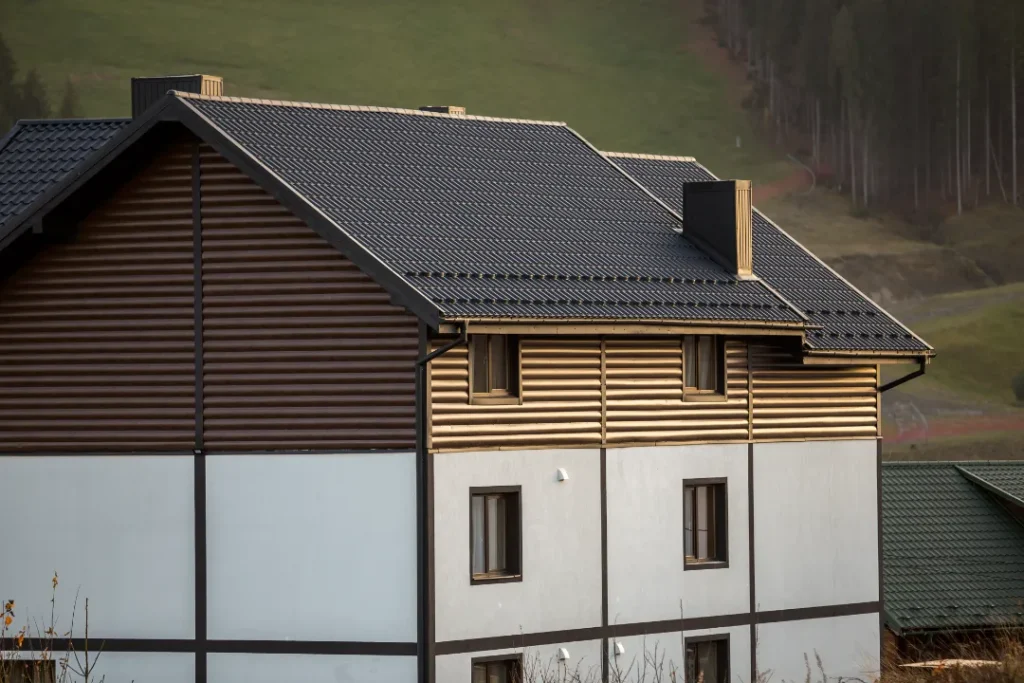
Determining the Ideal Minimum Slope for Your Metal Roof
The quest for the perfect roof slope begins with understanding the minimum pitch for metal roofing systems. These minimum slope requirements are not arbitrary; they are based on ensuring optimal performance and compatibility with the roof structure.
For instance, manufacturers typically recommend a minimum pitch of 3:12 for metal roofs, which translates to a three-inch vertical drop for every foot of horizontal distance.
Guidelines for Standing Seam Metal Roofs
Standing seam metal roofs are a marvel for low-slope applications, making them an excellent choice for low-slope metal roofs. Their design allows for a shallow minimum slope of 1/4:12, making them suitable for nearly flat roofs.
Single or double-lock standing seams, including snap-lock standing seams, provide a watertight seal ideal for these low-sloped surfaces.
Criteria for Corrugated Metal Panels
Corrugated metal panels offer versatility. With a minimum slope requirement of 1/2:12, they can be used on various building types, from agricultural to residential.
Specific corrugated roof panels, like the R Panel, require a minimum pitch of 1:12 to ensure proper water runoff and optimal roof performance.
Selection Tips for Low-Sloped Roof Options
When selecting metal roofing for low-sloped roofs, it is essential to consider local building codes, which outline the required specifications for safety and performance.
Additionally, the roof deck’s design and the building’s structural requirements must be considered to ensure the chosen metal roofing panels match suitably.
Measuring and Calculating Roof Pitch
Determining the exact pitch of a roof is essential for a successful roofing project. The slope of a roof is typically expressed as a ratio of vertical rise to horizontal run, with precise measurement being critical to the proper installation of metal roofing panels.
Tools Needed for Accurate Measurement
To accurately measure a roof’s pitch, you will need a collection of tools, including a level, tape measure, and pencil for marking.
For more complex measurements, a builder’s square and an inclinometer or protractor may come in handy to ensure precise angle determination.
Step-by-Step Guide to Measuring Slope
The process of measuring roof slopes is straightforward but requires attention to detail. Using the rise-over-run method, you compare the vertical height (rise) to a fixed 12-inch horizontal distance (run).
This measurement provides the slope ratio necessary to select the suitable metal roofing materials and ensure proper installation.
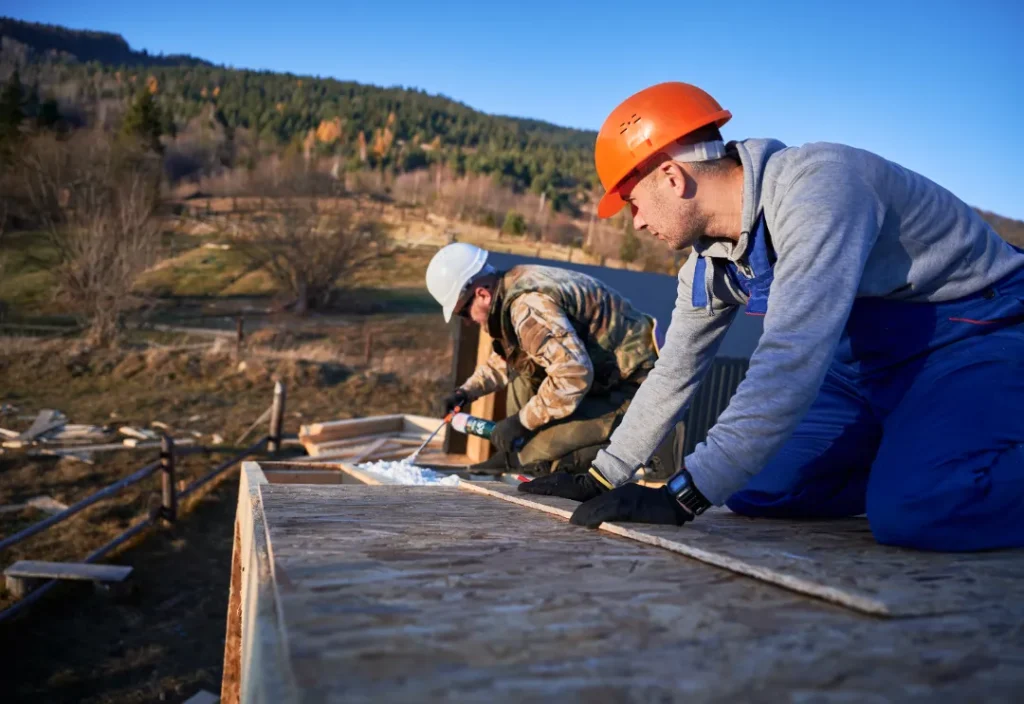
Xterior LLC: Your Partner in Metal Roofing Solutions
For those in North Carolina, Xterior LLC offers the following:
- A steadfast partner in the world of metal roofing solutions
- A commitment to excellence
- A wealth of experience in installations tailored to the local climate
- A premier roofing contractor
Expertise in Metal Roof Installation
We at Xterior LLC are renowned for our high-quality craftsmanship and use of durable materials, resulting in metal roof installations that are visually appealing and resilient against North Carolina’s dynamic weather conditions.
Financing and Free Estimates
Understanding that upgrading to a metal roof is a significant investment, Xterior LLC offers financing options and free no-obligation estimates to make this decision more accessible to homeowners.
Emergency Services for Weather Protection
Furthermore, Xterior LLC is prepared to respond swiftly to weather-related emergencies, providing tarping services to protect homes from immediate damages.
Choosing the Right Metal Roofing Material
Several factors must be considered when selecting a suitable metal roofing material. Climate, aesthetics, and structural requirements are pivotal in determining the best material for your roofing project.
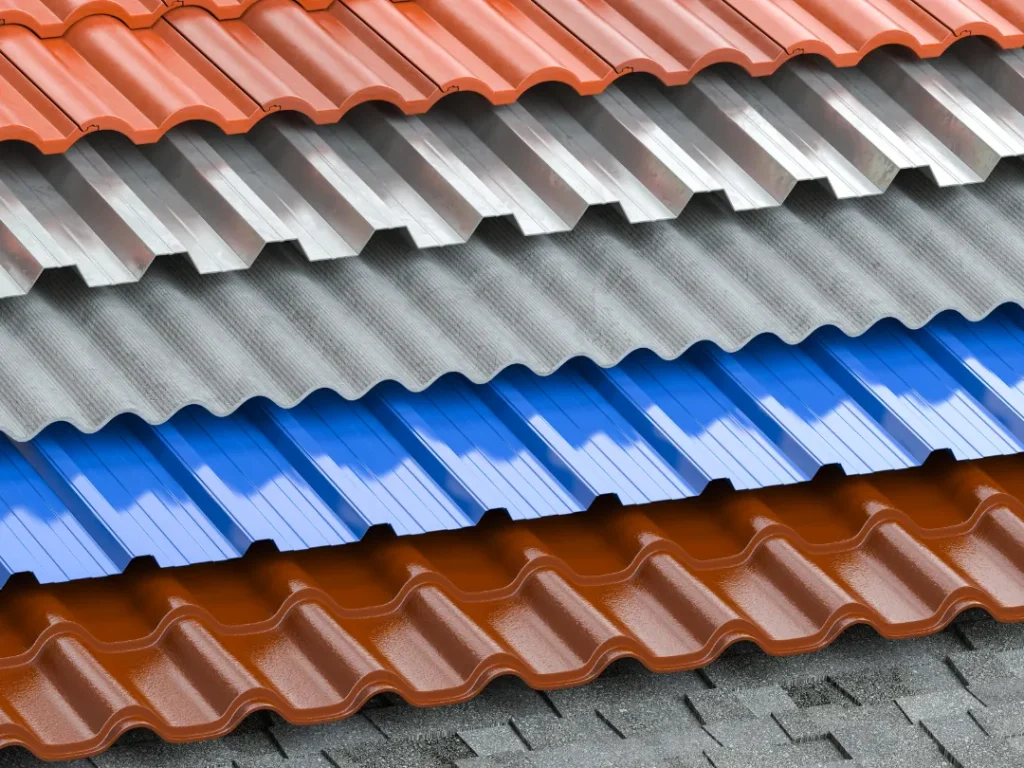
Matching Material to Climate Conditions
The local climate should be one of the primary considerations when choosing a metal roofing material. Different metals, like steel or aluminum, offer varying degrees of resistance to weather conditions such as extreme heat or heavy rainfall.
Aesthetic Considerations for Metal Roofs
Metal roofing should complement the building’s architectural style. Standing seam metal roofing, for example, can provide a sleek, modern look that enhances the building’s curb appeal.
Structural Requirements for Metal Roofing
It’s also imperative to ensure that the selected metal roofing materials are compatible with the roof’s structural design.
The complexity of a roof can influence the type of metal roofing profile suitable for installation, including the use of metal roof panels and metal roofing panel options.
Professional Installation Matters
The success of a metal roofing project hinges on professional installation. Skilled roofers are indispensable in preventing leaks, particularly on low-sloped roofs, and ensuring the roof is installed correctly.
Importance of Following Approved Installation Guidelines
Adherence to the approved manufacturer’s installation instructions is crucial in achieving a weather-tight and structurally sound roof. Contractors must ensure all components are positioned correctly to avoid performance issues.
Benefits of Hiring Skilled Roofers
Hiring skilled roofers from reputable companies like Xterior LLC ensures the optimal performance of your metal roof. Every detail, from the placement of fasteners to the application of sealants, is handled precisely.
Summary
In conclusion, understanding the nuances of metal roof slopes is not just about technicality but about ensuring the longevity, efficiency, and beauty of your home’s crowning glory.
With proper guidance and the expertise of Xterior LLC, your metal roofing project can withstand the test of time and nature.
Frequently Asked Questions
What is the recommended minimum pitch for a metal roof?
The recommended minimum pitch for a metal roof is 3:12, which equates to a vertical drop of three inches for every foot of horizontal distance. Maintaining this pitch ensures proper water drainage and prevents leaks.
Can standing seam metal roofs be installed on low-slope roofs?
Yes, standing seam metal roofs can be installed on low-slope roofs with minimum slopes as low as 1/4:12, which is suitable for installation.
What should I consider when choosing a metal roofing material?
When choosing a metal roofing material, consider the local climate, desired aesthetics, and structural design of your building to ensure optimal performance and longevity.
Why is professional installation necessary for metal roofs?
Professional installation is essential for metal roofs because it prevents leaks, ensures correct installation, and follows manufacturer-approved guidelines, resulting in a structurally sound and weather-tight roof.
Does Xterior LLC offer any financial assistance for metal roof installation?
Yes, Xterior LLC offers financing options and free estimates to help homeowners manage the costs of upgrading to a metal roof. These can be a valuable resource for those considering a metal roof installation.
Disclaimer:
The content in this blog is for informational purposes only and is intended to assist homeowners in understanding roofing, siding, windows, gutters, shutters, and general home improvements. Xterior LLC advises against attempting any of the tasks described here, as they require professional expertise. We do not assume liability for any injuries, damages, or losses resulting from DIY attempts. Always refer to the manufacturer of products for specific maintenance instructions.
By viewing this blog, you acknowledge and release Xterior LLC from any and all liability related to the use or misuse of the information provided.
Please note that Xterior LLC may not offer all the services discussed. Repairs, estimates, and inspections are priced based on availability, location, and time. All services, offerings, and prices are subject to change without notice.
For more information or to request services, please contact Xterior LLC directly.
